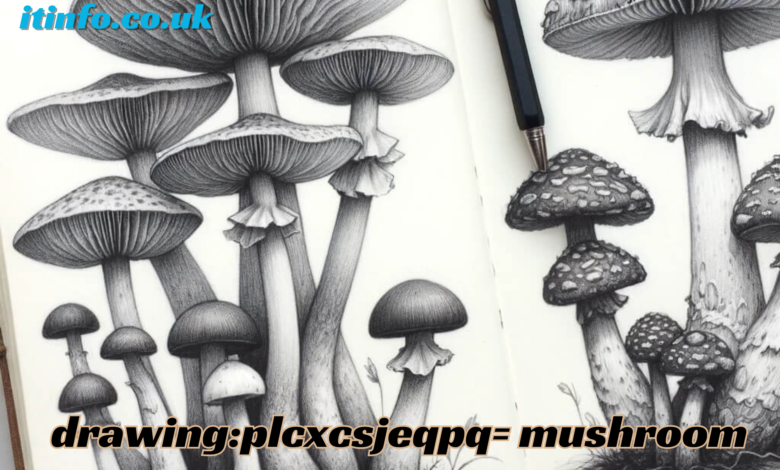drawing:plcxcsjeqpq= mushroom: Tips and Techniques for Captivating Mushroom Illustrations

Introduction to drawing:plcxcsjeqpq= mushroom
drawing:plcxcsjeqpq= mushroom Mushrooms are fascinating organisms, bursting with unique forms and colors that can inspire any artist. Whether you’re a beginner or an experienced illustrator, capturing the essence of mushrooms on paper can be both challenging and rewarding. From the delicate curves of their caps to the intricate patterns on their stems, each mushroom tells its own story. In this post, we’ll explore essential tips and techniques for drawing captivating mushroom illustrations that will bring your artistic vision to life. Grab your sketchbook and let’s embark on this creative journey together!
Tips for Sketching Mushrooms
Sketching mushrooms begins with observation. Take the time to study their shapes, sizes, and unique features. Each variety has its own character.
Start with light pencil strokes to outline the basic structure. Focus on the cap, stem, and gills. Use a reference photo or look at real mushrooms for inspiration.
Pay attention to proportions; some species have thick stems while others are slender and delicate. Don’t be afraid to exaggerate certain aspects for artistic flair.
Add details gradually. Capture textures like smooth caps or fuzzy stems by varying your line weight. Experiment with cross-hatching techniques for shading effects that give depth.
Practice makes perfect! The more you sketch different types of mushrooms, the more confident you’ll become in depicting their beauty on paper.
Techniques for Adding Depth and Texture to Mushroom Drawings
To create captivating mushroom illustrations, adding depth and texture is essential. Start by observing real mushrooms closely. Notice the subtle variations in their surfaces.
Use hatching and cross-hatching techniques to define contours. This method helps simulate shadows and highlights effectively. Layering these lines can instantly enhance the three-dimensional feel of your drawing.
Don’t shy away from experimenting with stippling as well. Tiny dots can convey a sense of roughness or smoothness, depending on how densely packed you place them.
Creating gradients through shading adds another layer of realism. A soft pencil or blending stump works wonders for achieving that seamless transition between light and shadow.
Consider incorporating mixed media like colored pencils or watercolors after your initial sketching phase. These mediums can emphasize textures uniquely while breathing life into your illustrations.
Using Color to Bring Your Mushroom Illustrations to Life
Color plays a vital role in mushroom illustrations. It can evoke emotions and set the overall mood of your artwork. Start by observing real mushrooms in nature. Notice their vibrant hues, from earthy browns to striking reds.
When selecting colors, think about contrast. A deep green background can make bright orange caps pop visually. Experiment with different palettes to see how they affect your piece drawing:plcxcsjeqpq= mushroom.
Layering is another technique worth exploring. Use lighter shades for highlights and darker tones for shadows. This adds dimension, making your mushrooms appear more lifelike.
Don’t shy away from unconventional colors either! Imagine a whimsical world where purple fungi flourish among turquoise grass—let creativity guide you drawing:plcxcsjeqpq= mushroom.
Always pay attention to light sources when applying color. The way light interacts with surfaces creates unique effects that enhance realism in your illustrations.
Common Mistakes to Avoid in Mushroom Illustrations
When diving into mushroom illustrations, it’s easy to overlook some fundamental aspects. One common mistake is failing to observe proportions accurately. Mushrooms come in various shapes and sizes; getting these details right enhances realism drawing:plcxcsjeqpq= mushroom.
Another pitfall is neglecting the environment around the mushrooms. A lone fungus on a blank page can feel disconnected. Incorporating elements like grass or fallen leaves creates context and depth.
Many artists also rush through shading, resulting in flat images. Remember that shadows and highlights are crucial for dimension drawing:plcxcsjeqpq= mushroom.
Using an overly rigid style can stifle creativity as well. Allow your personal touch to shine through each illustration without adhering strictly to realism.
Avoid using excessive detail that clutters your work instead of enhancing it. Simplicity often speaks volumes in art, especially when capturing nature’s beauty like mushrooms effectively.
Inspiration and Resources for Mushroom Art
Mushroom art thrives on inspiration from nature’s intricate designs. Walk through a forest or stroll in your garden to discover various mushroom species. Each one has its own unique shape, color, and texture that can spark creativity drawing:plcxcsjeqpq= mushroom.
Books focusing on mycology or botanical illustration offer valuable insights into the world of fungi. They often contain stunning visuals alongside detailed descriptions.
Online platforms like Instagram and Pinterest are treasure troves for mushroom enthusiasts. Follow artists who specialize in mycelium masterpieces to ignite your imagination drawing:plcxcsjeqpq= mushroom.
Consider visiting local art exhibits showcasing natural themes. Engaging with other artists can provide fresh perspectives and techniques you may not have thought of before.
Don’t overlook online tutorials and workshops dedicated to drawing mushrooms specifically. These resources will guide you while allowing your personal style to shine through drawing:plcxcsjeqpq= mushroom.
Conclusion
Mushroom illustration is a fascinating blend of art and nature. By mastering the tips and techniques outlined, you can create captivating drawings that celebrate the unique beauty of these fungi. drawing:plcxcsjeqpq= mushroom Whether you’re sketching in a notebook or working on detailed illustrations, remember to embrace your own style. With practice and exploration, your mushroom artwork will continue to evolve drawing:plcxcsjeqpq= mushroom.
Don’t hesitate to draw inspiration from various resources available online and in books dedicated to botanical art. Keep experimenting with colors, textures, and forms until you find what resonates with you. Each piece is an opportunity for growth as an artist.
Let your passion for mushrooms guide your creative journey. The world of mushroom drawing awaits!
